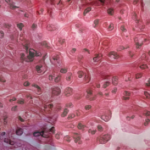DESTIN, FLORIDA—Management of lupus nephritis is an evolving area with several new therapies introduced in recent years. During the annual Clinical Congress of Rheumatology East in May, Michelle Petri, MD, MPH, MACR, gave a presentation titled It Is Time to Rethink Lupus Nephritis, in which she shared her personal treatment perspectives.
Dr. Petri is a professor of medicine in the Division of Rheumatology at Johns Hopkins University, Baltimore, and the director of the Hopkins Lupus Center. She kicked off the talk by joking, “There are very few easy things in lupus. And I’m going to take away one of them: lupus nephritis.”
Proteinuria Misconceptions
Dr. Petri highlighted a common misconception regarding a proteinuria threshold for kidney biopsy to evaluate for lupus nephritis. “We think you do not have to biopsy until the proteinuria hits 500 mg,” Dr. Petri said. “And in clinical trials, we call it a ‘complete renal response’ if we get the proteinuria below 500 mg. [But] there’s nothing normal about having 500 mg of proteinuria.”
In the general population, microalbuminuria has been associated with an increase in all-cause mortality and major adverse cardiovascular events among patients with hypertension.1 Reduction of microalbuminuria has been associated with a reduced risk of cardiovascular events in patients with hypertension and diabetes.2 Given this, Dr. Petri asked, “Why are we waiting for 500 mg?”
In the Accelerating Medicines Partnership (AMP), researchers are evaluating biopsy in patients with SLE with proteinuria between 250 mg and 499 mg. “About 70% of those patients will have actionable lupus nephritis, meaning membranous or proliferative [disease],” Dr. Petri said.
Proteinuria can be caused by lupus activity, chronic damage or both, making it a challenging metric to interpret. “You cannot trust the complete renal response to tell you how your patient is going to do [in the] long term,” Dr. Petri said. “Our lupus nephritis trials need to be long term, with an outcome of change in GFR [glomerular filtration rate] slope, not just proteinuria.”
Dr. Petri noted that in their first lupus nephritis episode, by the time we do a kidney biopsy, a patient can already have lost one-third of their nephrons.3 Data from a phase 3 lupus nephritis trial of belimumab demonstrated protection of the GFR over time in those on belimumab compared with placebo.4 SGLT2 inhibitor use is also an area of current interest, but with conflicting data in SLE to date regarding its ability to protect the GFR.



